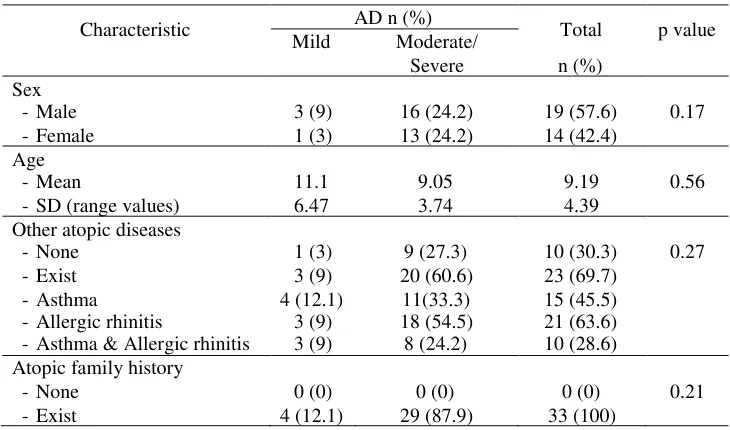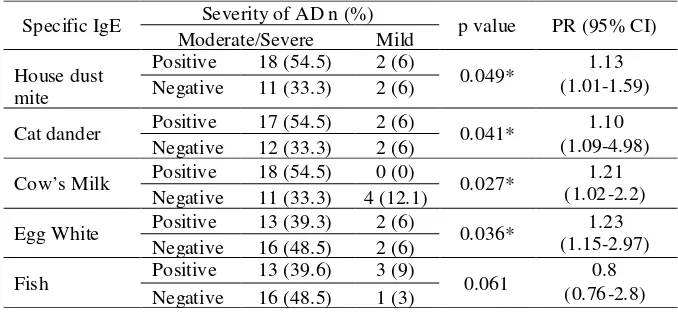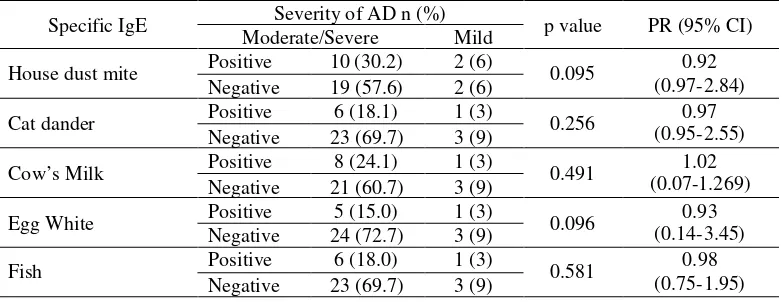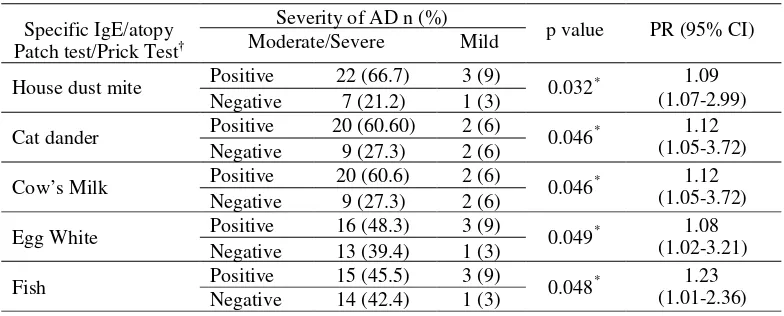* corresponding author: hardyanto@ugm.ac.id
Association between environmental allergen
sensitization with severity of atopic
dermatitis in children and young adult at
Dr. Sardjito General Hospital, Yogyakarta
Herwinda Brahmanti, Niken Trisnowati, Retno Danarti, Hardyanto Soebono*
Department of Dermatovenerology, Faculty of Medicine/Dr. Sardjito General Hospital, Gadjah Mada University, Yogyakarta, Indonesia
ABSTRACT
The important role of aeroallergens and food allergens as the most common environmental allergens in exacerbation of atopic dermatitis (AD) is well known. Sensitization is an essential process which correlates with clinical manifestation of AD. The study of AD in Indonesia, especially in Yogyakarta, has not been reported, yet. The aim of study is to evaluate the association between sensitization of environmental allergens with clinical severity of AD in children and young adult at Dr. Sardjito General Hospital, Yogyakarta. An analytic observational cross sectional study was performed on 33 children and young adult with AD. The severity of disease was determined by SCORing Atopic Dermatitis (SCORAD). Assessment of sensitization was performed using specific IgE serum, atopy patch test, and prick test. Data were analyzed using chi-square or Fisher exact test and prevalence ratio (PR) with significance value of p<0.05 and 95% confidence interval (CI). The results showed that specific IgE positivity was associated with severity of AD. Percentage of specific IgE positivity to house dust mite was significantly higher in subject with moderate/severe AD compared to those of mild AD (p=0.049; PR 1.13; 95% CI 1.01-1.59). The result was also similar for cat dander (p=0.041; PR 1.1; 95% CI 1.09-4.98), cow’s milk (p=0.038; PR 1.21; 95% CI 1.02-2.2), and egg white (p=0.027; PR 1.23; 95% CI 1.15-2.97). Whereas specific IgE positivity to fish allergen was not statistically different in subject with moderate/severe AD compared to those with mild AD (p=0.061; PR 0.8; 95% CI 0.76-2.8). According to atopy patch test and prick test result, no association was found between allergen sensitization and severity of AD. If all methods were combined to increase the sensitivity of sensitization measurement, then the association was found for all allergens. It could be concluded that environmental allergens sensitization is associated with severity of AD in children and young adult at Dr. Sardjito General Hospital, Yogyakarta.
Key words: atopic dermatitis-disease severity-sensitization-aeroallergen-food allergen
INTRODUCTION
Atopic dermatitis (AD) is a chronic and recurrent inflammatory skin disease that occurs especially in infants and children, but can also be found in adulthood. The etiology is still unknown. The pathogenesis is complex and involves many factors, makes AD is described as a multifactorial disease. The prevalence of AD has increased more than threefold since 1960 and became a worldwide health problem.1
The role of allergy in the pathogenesis of AD is still controversial. However, it is known that exposure to environmental allergens can stimulate
the emergence of AD lesion. Environmental allergens that most frequently involved in the pathogenesis of AD are food and aeroallergens.2
was associated with the severity of AD.2-4Study of
AD in Indonesia, especially in Yogyakarta, has not been reported, yet.
The study aimed at exploring the association between environmental allergens sensitization with the severity of AD in children and young adult at Dr. Sardjito General Hospital Yogyakarta, Indonesia.
MATERIALS AND METHODS
This study was conducted at the Outpatient Clinic of Department of Dermatovenerology, Faculty of Medicine, Gadjah Mada University/Dr. Sardjito General Hospital Yogyakarta, commencing in September 2009 until reach the number of 33 subjects. A cross sectional analytic observational study was designed.
The inclusion criteria were men or women between the ages 2-25 years with AD in which the diagnosis was based on the criteria of Hanifin Rajka, had lived in Yogyakarta for a minimum of two years, subjects or parents understood the procedures and side effects that might occur during the procedures, and agreed to participate in this study. The exclusion criteria were subjects on systemic immuno-modulatory therapy within the last four weeks before study, subjects in topical corticosteroid therapy within the last four weeks before study, and subjects taking systemic antihistamines at least one week before study.
Sensitization was measured by using three methods, IgE specific (Euroline® system), atopy
patch test and prick test to house dust mites (Dermatophagoides pteronyssinus),cat dander, egg
white, cow’s milk and fish. Measurement of sensitization was considered “positive” if IgE specific level was >0.35 kU/I (RAST class 1) or prick test result showed diameter of wheal e”3 mm or at least ½ diameter of positive control or atopy patch test result showed positive 1 to positive 4 reaction according to European Task Force of Atopic Dermatitis(EFTAD).
Degree of severity of AD was determined by
SCORing Atopic Dermatitis(SCORAD). Data were
analyzed using non-parametric test of chi-square or Fisher with a significance of p<0.05, prevalence ratio (PR) with 95% confidence interval (CI).
This study has been approved by The Medical and Health Research Ethics Committee of Faculty of Medicine, Gadjah Mada University, Yogyakarta.
RESULTS
Thirty three subjects participated in this study and fulfilled the inclusion criteria. They were categorized into 2 groups, 4 (12.1%) subjects with mild AD and 29 (87.8%) subjects with moderate to severe AD (moderate/severe). The characteristic of subjects is shown in TABLE 1.
TABLE 1. Characteristic of subjects
Characteristic AD n (%) Total
n (%)
- SD (range values)
11.1
- Asthma & Allergic rhinitis
The mean value of SCORAD was 49.19 ± 14.87 (16.04 to 81.27). Test of homogeneity of gender, age, other atopic diseases and atopic diseases in the family showed no significant difference.
FIGURE 1. Distribution of sensitization test to 5 allergens according to three methods
Distribution of allergen sensitization according to specific IgE, prick test and atopy patch test can be seen in FIGURE 1.
The majority of positive result was demonstrated by specific IgE, followed by atopy patch test and prick test. House dust mite (60.6%, 36.4%, and 36.4%) was found as the most common allergens. Specific IgE positivity was associated with severity of AD (TABLE 2). Percentage of specific IgE positivity to house dust mite was significantly
higher in subject with moderate/severeAD compared to those of mild AD (p=0.049; PR 1.13; 95% CI 1.01-1.59). The result was also similar for cat dander (p=0.041; PR 1.1; 95% CI 1.09-4.98), cow’s milk (p=0.038; PR 1.21; 95% CI 1.02-2.2), and egg white (p=0.027; PR 1.23; 95% CI 1.15-2.97).
TABLE 2. Association between environmental allergen sensitization according to specific IgE with severity of AD
Specific IgE Severity of AD n (%) p value PR (95% CI) Moderate/Severe Mild
House dust mite
Positive 18 (54.5) 2 (6)
0.049* (1.01-1.59)1.13 Negative 11 (33.3) 2 (6)
Cat dander Positive 17 (54.5) 2 (6) 0.041* 1.10
(1.09-4.98) Negative 12 (33.3) 2 (6)
Cow’s Milk Positive 18 (54.5) 0 (0) 0.027* (1.02-2.2)1.21 Negative 11 (33.3) 4 (12.1)
Egg White Positive 13 (39.3) 2 (6) 0.036* (1.15-2.97)1.23 Negative 16 (48.5) 2 (6)
Fish Positive 13 (39.6) 3 (9) 0.061 (0.76-2.8)0.8
Negative 16 (48.5) 1 (3)
According to atopy patch test, no association was found between allergen sensitization and severity of AD (TABLE 3). Percentage of atopy patch test positivity to house dust mite was not significantly higher in subject with moderate/severe AD compared to those of mild AD (p=0.095; PR
0.92; 95% CI 0.97-2.84). The result was also similar for cat dander (p=0.256; PR 0.97; 95% CI 0.95-2.55), cow’s milk (p=0.491; 7 PR 1.02; 95% CI 0.07-1.69), egg white (p=0.096; PR 0.93; 95% CI 0.14-3.45), and fish (p=0.581; PR 0.581; 95% CI 0.75-1.95).
Specific IgE Severity of AD n (%) p value PR (95% CI)
Moderate/Severe Mild
House dust mite Positive 10 (30.2) 2 (6) 0.095 0.92
(0.97-2.84) Negative 19 (57.6) 2 (6)
Cat dander Positive 6 (18.1) 1 (3) 0.256 (0.95-2.55)0.97
Negative 23 (69.7) 3 (9)
Cow’s Milk Positive 8 (24.1) 1 (3) 0.491 (0.07-1.269)1.02
Negative 21 (60.7) 3 (9)
Egg White Positive 5 (15.0) 1 (3) 0.096 (0.14-3.45)0.93
Negative 24 (72.7) 3 (9)
Fish Positive 6 (18.0) 1 (3) 0.581 0.98
(0.75-1.95) Negative 23 (69.7) 3 (9)
PR=prevalence ratio; CI=confidence interval
TABLE 3. Association between environmental allergen sensitization according to atopy patch test with severity of AD
According to prick test, no association was found between allergen sensitization and severity ofAD (TABLE 4). Percentage of prick test positivity to house dust mite was not significantly higher in subject with moderate/severe AD compared to those
of mild AD (p=0.097; PR 1.07; 95% CI 0.11-1.41). The result was also similar for cat dander (p=0.769; PR 1.15; 95% CI 0.82-1.31), cow’s milk (p=0.670; PR 1.15; 95% CI 0.77-2.01), and fish (p=0.879; PR 1.15; 95% CI 0.039-1.3).
TABLE 4. Association between environmental allergen sensitization according to prick test with severity of AD
Specific IgE Severity of AD n (%) p value PR (95% CI)
Moderate/Severe Mild
House dust mite Positive 11 (63.6) 1 (3) 0.097 (0.11-1.41)1.07 Negative 18 (24.2) 3 (9)
Cat dander Positive 2 (6) 0 (0) 0.769 (0.82-1.31)1.15
Negative 27 (81.8) 4 (12.1)
Cow’s Milk Positive 3 (9) 0 (0) 0.670 1.15
(0.77-2.01) Negative 26 (78.8) 4 (12.1)
Egg White Positive 0 (0) 0 (0) NA NA
NA Negative 29 (57.6) 4 (12.1)
Fish Positive 1 (100) 0 (0) 0.879 1.15
(0.04-1.30) Negative 28 (84.9) 4 (12.1)
NA= not available; PR=prevalence ratio; CI=confidence interval
If all of those three of methods (IgE specific, atopy patch test and prick test) were combined to
TABLE 5. Association between environmental allergen sensitization according to sensitization test with severity of AD
Specific IgE/atopy Patch test/Prick Test†
Severity of AD n (%)
p value PR (95% CI)
Moderate/Severe Mild
House dust mite Positive 22 (66.7) 3 (9) 0.032* 1.09
(1.07-2.99)
Negative 7 (21.2) 1 (3)
Cat dander Positive 20 (60.60) 2 (6) 0.046* (1.05-3.72)1.12
Negative 9 (27.3) 2 (6)
Cow’s Milk Positive 20 (60.6) 2 (6) 0.046* (1.05-3.72)1.12
Negative 9 (27.3) 2 (6)
Egg White Positive 16 (48.3) 3 (9) 0.049* (1.02-3.21)1.08
Negative 13 (39.4) 1 (3)
Fish Positive 15 (45.5) 3 (9) 0.048* (1.01-2.36)1.23
Negative 14 (42.4) 1 (3)
*p<0,05 Fisher exact test; PR=prevalence ratio; CI=confidence interval,
†
Positive sensitization define by positive result in one of three sensitization methods (specific IgE >0.35 kU/I OR diameter of prick test’ wheal e”3 mm or at least ½ diameter of positive control OR atopy patch test showed +1 to +4 reaction)
According to combination of three methods (IgE specific, atopy patch test and prick test) for parameter of sensitization, association was found between environmental allergen sensitization and severity of AD (TABLE 8). Percentage of specific IgE positivity or atopy patch test positivity or prick test positivity to house dust mite was significantly higher in subject with moderate/severeAD compared to those of mild AD (p=0.031; PR 1.09; 95% CI 1.07-2.99). The result was also similar for cat dander (p=0.046; PR 1.12; 95% CI 1.05-3.72), cow’s milk (p=0.046; PR 1.12; 95% CI 1.05-3.72), egg white (p=0.049; PR 1.08; 95% CI 1.02-3.21), and fish (p=0.048; PR 1.23; 95% CI 1.01-2.36).
DISCUSSION
This study involved thirty three subjects of children and young adults with AD in various degree of severity. They were categorized into 2 groups, those with mild AD and those with moderate/severe AD based on differences in risk of complication and management.5,6
The results of this study indicated that most of sensitizations were found to aeroallergen (house dust mites), followed by food allergen (cow’s milk) (FIGURE 1). The percentage of positive results in the sensitization test to aeroallergens was higher than food allergens in this study because the mean age of subjects was 9.19 years in which the pattern of
sensitization has been largely influenced by aeroallergens.7,8
House dust mite species were mostly found in the environment, namely Dermatophagoides pteronyssinus (Der p) and Dermatophagoides farinae(Der f).9Many studies focused on Der p 1
as the most commons allergens that were found in high concentrations in mite faeces.
Dermatophagoides pteronyssinus is important in
the pathogenesis of AD because it shows high cysteine protease activity, therefore Der p 1 has IgE binding capability of 80-100% and it also has the ability to induce Th2 cytokine production. High titer of specific antibodies of Der p 1 was found in 95% AD and was correlated with disease severity.7,9-11
Schafer et al.12 suggested that the level of sensitization inAD influenced the occurrence of skin manifestations and affected the severity of disease with a linear pattern. The results of this study indicated that the association between environmental allergen sensitization as shown by specific IgE levels with the severity of AD was found (TABLE 2). These results were also consistent with Katoh et al.13 which showed that AD with high specific IgE
values (> 17.5 kU/I) was associated with extensive area involvement after 10 years of evaluation.
compared to atopy patch test and prick test. Several studies had using specific IgE as the gold standard measurement of allergen sensitization.14-16 This
method can be performed in cases where prick test are contraindication such as the presence of lesions in the test area or in conditions under drugs intervention.12In children, measurement of specific
IgE is recommended because it is easy and less invasive than prick test and atopy patch test.16,17
In this study, percentage of sensitization test positivity according to either one of atopy patch test or prick test was not significantly higher in subject with moderate/severe AD compared to those of mild AD. However, the number of atopy patch test and prick test positivity were higher in moderate/severe AD (TABLE 3 and 4). This result was consistent with Holmet al.7and Laskeet al.18that sensitization to aeroallergens and food allergens are in line with severity of AD.
Atopy patch testing performed in this study was using prick test allergens produced by Dr. Indrayana, LAPI Jakarta. It was possible that the concentration of allergens was too low to induced sensitization. Optimal dose of aeroallergens which can induce skin reactions in atopy patch test is 5000-7000 units per gram of protein nitrogen in petrolatum.19However,
Shankar and Chakravarthi in 2008 also performed atopy patch testing by using aqueous prick test allergen with aeroallergen concentrations ranging from 1500-5000 per unit of protein nitrogen grams and food allergens at 1% w/v and the results showed that the application of prick test allergens to intact skin can cause skin reactions. Other causes which influenced the atopy patch test results in this study was the tendency of parents to bring their children to hospital in an acute state of AD was larger than those with a chronic state of AD. Atopy patch test is a test method based on delayed type of hypersensitivity reactions, therefore in most subjects this reaction has not occurred.20
Prick test results in this study was not associated with the severity of AD, which was in line with Berger21and Seinedariet al.22that suggested that
the prick test can not be used as a predictor of the severity of AD in children. Prick test reactivity was higher in patients more than 15 years old, while positive results on atopy patch test were more often
this study, where the average age of subjects was 9.19 years. Prick test also has positive predictive value of less than 40%, this suggested that individuals with a positive prick test results to certain allergens may not experience any disruption when exposed to these allergens.16
The results of this study indicated that when the three tests were used in a combination to increase the sensitivity, the percentage of sensitization test positivity became higher and statistically significant for all allergens (TABLE 5). This means that those methods are complementary, therefore that it is expected to increase the sensitivity of diagnostic tests.16Complete process of sensitization would be
obtainable by using combination of several methods of sensitization test. Specific IgE determines allergen specific IgE antibodies in the serum and, in contrast with SPT, gives a quantitative result of detected IgE antibodies which bind to the surface of mast cell, whereas atopy patch test represents T cell mediated delayed response of sensitization.23-25Prick
test and specific IgE measurement are important for determination of sensitization in AD, but the accuracy of those examination are reduced in the delayed type manifestation of allergic diseases, especially food allergies. In this case, atopy patch test is helpful in determining sensitization in AD.26,27
The limitation of this study was the marked difference number of subject between mild AD (4/ 12.1%) and moderate/severe AD (29/87.8%) that may cause insignificant analysis. Another limitation of cross sectional design is that we can not conclude whether the sensitization preceed the severity of AD or vice versa.
CONCLUSION
The results of this study concluded that the sensitization towards environmental allergens associated with severity ofAD in children and young adults at Dr. Sardjito General Hospital, Yogyakarta.
ACKNOWLEDGMENT
REFERENCES
1. Leung DYM, Eichenfield LF, Boguniewicz M. Atopic dermatitis (atopic eczema). In: Wolff K, Goldsmith LA, Katz SI, Gilchrest BA, Paller AS, Leffell DJ, editors. Fitzpatrick’s Dermatology in General Medicine 7thedition.
New York: McGraw-Hill, 2008:146-58.
2. RemitzA, Reitamo S. The clinical manifestations of atopic dermatitis. In: Reitamo S, Luger TA, Steinhoff M, editors. Textbook of Atopic Dermatitis. London: Informa Healthcare, 2008:1-12.
3. Ricci G, Patrizi A, Baldi E, Menna G, Tabanelli M, Masi M. Long-term follow-up of atopic dermatitis: Retrospective analysis of related risk factors and association with concomitant allergic diseases. JAm Acad Dermatol 2006;55:765-71.
4. Reitamo S, Lehto M, Virtanen H, Haapakoski R, Alenius H, Remitz A,et al. Possible clinical associations of atopic dermatitis with bronchial asthma. In: Reitamo S., Luger TA, Steinhoff M, editors. Textbook of Atopic Dermatitis. London: Informa Healthcare, 2008:237-45
5. Van der Hulst AE, Klip H, Brand PLP. Risk of developing asthma in young children with atopic eczema:Asystematic review. J Allergy Clin Immunol 2007;120:565-9. 6. Boguniewicz M, Nico N. General management of patients
with atopic dermatitis. In: Reitamo S, Luger TA, Steinhoff M, editors. Textbook of Atopic Dermatitis. London: Informa Healthcare, 2008:147-64
7. Holm L, Hage-Hamsten M, Öhman S, Scheynius A. Sensitization to allergen of house-dust mite in adults with atopic dermatitis in a cold temperate region. Allergy 1999; 54:708-15.
8. Michel S, Yawalkar N, Schnyder B, Fischer B, Helbling A. Eczematous skin reaction to atopy patch testing with cockroach in patients with atopic dermatitis. J Investig Allergol Clin Immunol 2009;19:173-9.
9. Dahbi-Mrabet S, Renz H. Role of inhalant allergens in atopic dermatitis. In: Reitamo S, Luger TA, Steinhoff M, editors. Textbook of Atopic Dermatitis. London: Informa Healthcare, 2008:101-15.
10. Friedmann PS. The role of dust mite antigen sensitization and atopic dermatitis. Clin Exp Allergy 1999;29:869–72. 11. Beltrani VS. The Role of house dust mite and other aeroallergen in atopic dermatitis. Clin Dermatol 2003;21:177-82.
12. Schäfer T, Heinrich J, Wjst M,Adam H, Ring J, Wichmann H. Association between severity of atopic eczema and degree of sensitization to aeroallergens in schoolchildren. JAllergy Clin Immunol 1999;104:1280-4.
13. Katoh N, Hirano S, Kishimoto S. Prognostic factor of adult patients with atopic dermatitis. J Dermatol 2008;35:477-83
14. Prescott SL, Macaubas C, Smallacombe T, Holt BJ, Sly PD. Development of allergen-specific Tcell in atopic and normal children. Lancet 1999;353:196–200.
15. Darsow U, Laifaoui J, Kerschenlohr K, Wollenberg A, Przybilla B, Wüthrich B,et al.The prevalence of positif reactions in the atopic patch test with aeroallergens and food allergens in subjects with atopic eczema: A European multicenter study. Allergy 2004;59:1318-25.
16. Lipozenèiæ J, Wolf R. The diagnostic value of atopy patch testing and prisk testing in atopic dermatitis: facts and controversies. Clin Dermatol 2010;28:38-44.
17. Baatenburg de Jong A, Dikkeschei LD, Brand PLP. High prevalence of sensitization to aeroallergens in children 4 yrs of age or younger with symptoms of allergic disease. Pediatr Allergy Immunol 2009;20:735–40.
18. Laske N, Niggemann B. Does the severity of atopic dermatitis correlate with serum IgE levels? Pediatr Allergy Immunol 2004;15:86–8
19. Darsow U, Vieluf D, Ring J. Evaluating the relevance of aeroallergen sensitization in atopic eczema with the atopy patch test: A randomized, double-blind multicenter study. J Am Acad Dermatol 1999;40:187-93.
20. Roitt I, Brostoff J, Male D. Hypersensitivity-Type IV. In: Roitt I, Brostoff J, Male D, editors. Immunology. 6th
edition. New York: Mosby, 2002:371-83.
21. Berger A. Science commentary: skin prick testing. BMJ 2002; 325:414.
22. Seidenari S, Giusti F, Bertoni L, Mantovani L. Combined skin prick and patch testing enhances identification of peanut-allergic patients with atopic dermatitis. Allergy 2003;58:495-9.
23. Hill DJ, Heine RG, Hosking CS. The diagnostic value of skin prick testing in children with food allergy. Pediatr Allergy Immunol 2004;15:435–41.
24. Schoefer Y, Schäfer T, Meisinger V, Wichmann HE, Heinrich J. Predictivity of allergic sensitization (RAST) for the onset of allergic diseases in adults. Allergy 2008; 63:81–6
25. Michel S, Yawalkar N, Schnyder B, Fischer B, Helbling A. 2009. Eczematous skin reaction to atopy patch testing with cockroach in patients with atopic dermatitis. J Investig Allergol Clin Immunol 2009;19:173-9.
26. Pajno GB, Peroni DG, Barberio G, Pietrobelli A, Boner AL. Predictive features for persistence of atopic dermatitis in children. Pediatr Allergy Immunol 2003;14:292-5



